Environmental Engineering: Mckinney Water Quality Report 2018
VerifiedAdded on 2023/02/01
|5
|1207
|27
Report
AI Summary
This report examines the water quality in Mckinney, Texas, based on the City of Mckinney Water Quality Report 2018, which analyzed data from 2017. The report highlights the city's superior water quality rating from the Texas Commission of Environmental Quality, assessing various contaminants like inorganic, organic, and radioactive substances, as well as disinfectant byproducts. A key issue discussed is water contamination from chemicals used for water treatment, specifically chlorine, and its byproducts, leading to environmental and health concerns such as skin irritations and respiratory problems. The report then explores management practices to minimize water pollution, including public education, spill prevention and cleanup, and illegal dumping controls, emphasizing the importance of public involvement and adherence to regulations in ensuring water quality. References to relevant research papers are included to support the findings and recommendations.
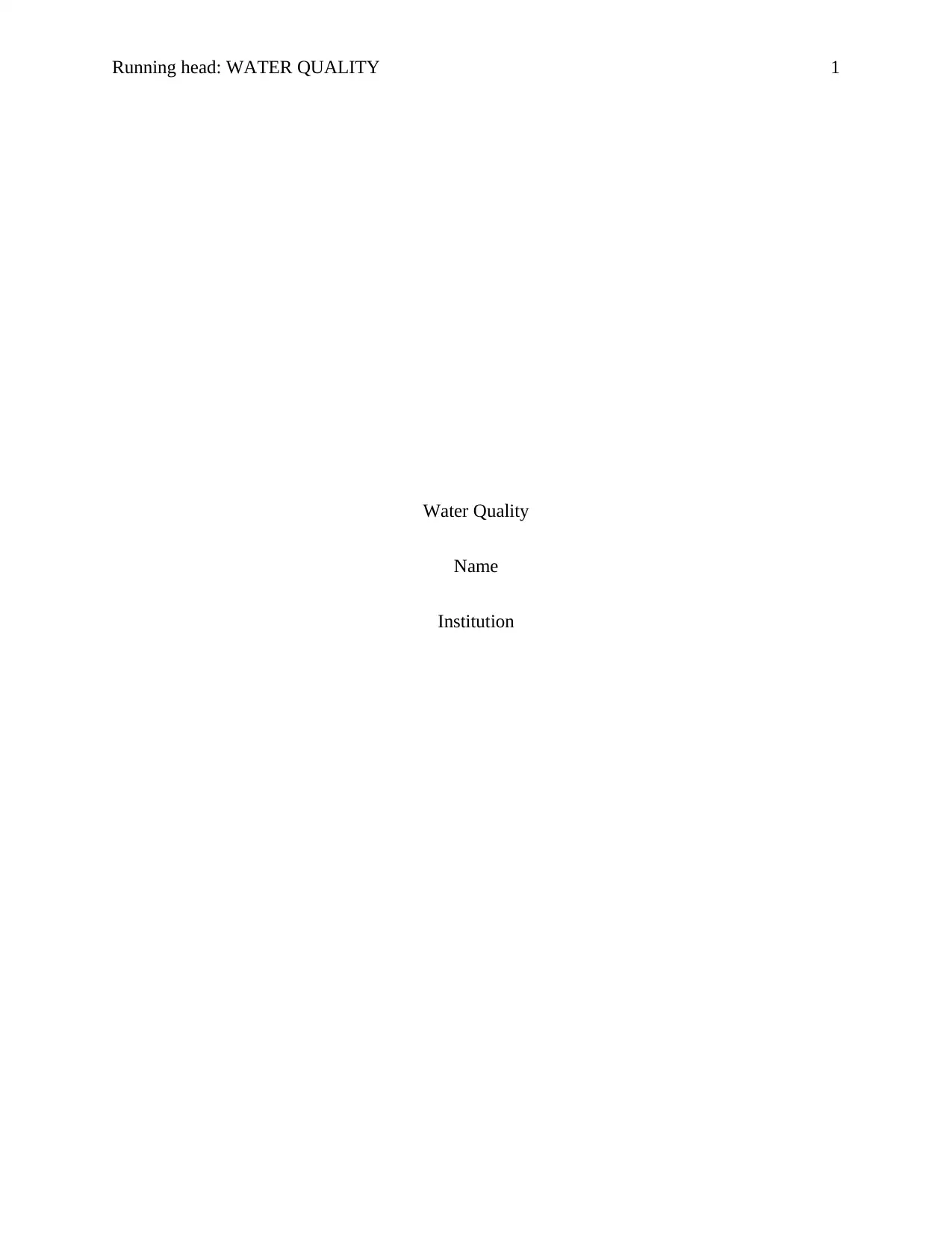
Running head: WATER QUALITY 1
Water Quality
Name
Institution
Water Quality
Name
Institution
Paraphrase This Document
Need a fresh take? Get an instant paraphrase of this document with our AI Paraphraser
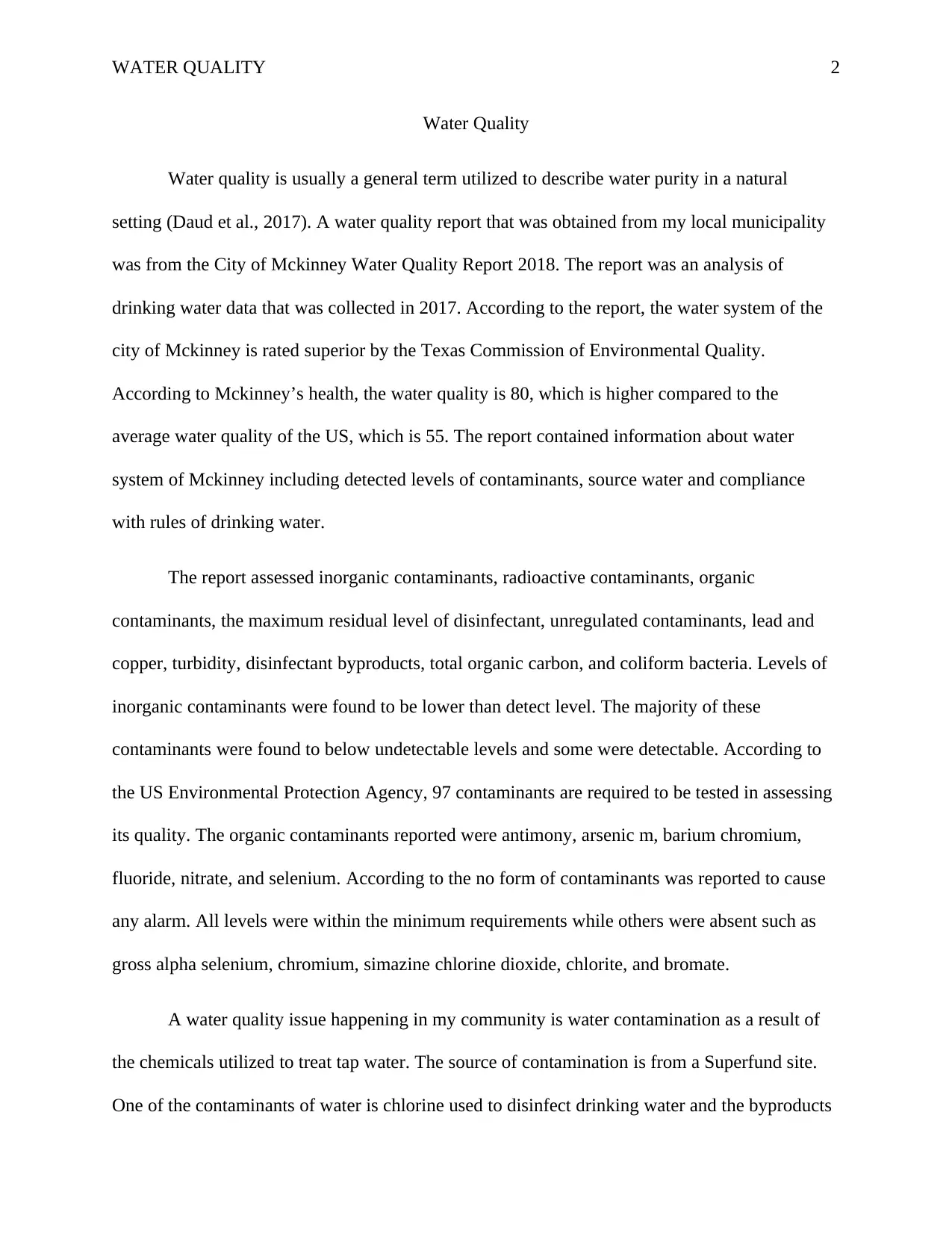
WATER QUALITY 2
Water Quality
Water quality is usually a general term utilized to describe water purity in a natural
setting (Daud et al., 2017). A water quality report that was obtained from my local municipality
was from the City of Mckinney Water Quality Report 2018. The report was an analysis of
drinking water data that was collected in 2017. According to the report, the water system of the
city of Mckinney is rated superior by the Texas Commission of Environmental Quality.
According to Mckinney’s health, the water quality is 80, which is higher compared to the
average water quality of the US, which is 55. The report contained information about water
system of Mckinney including detected levels of contaminants, source water and compliance
with rules of drinking water.
The report assessed inorganic contaminants, radioactive contaminants, organic
contaminants, the maximum residual level of disinfectant, unregulated contaminants, lead and
copper, turbidity, disinfectant byproducts, total organic carbon, and coliform bacteria. Levels of
inorganic contaminants were found to be lower than detect level. The majority of these
contaminants were found to below undetectable levels and some were detectable. According to
the US Environmental Protection Agency, 97 contaminants are required to be tested in assessing
its quality. The organic contaminants reported were antimony, arsenic m, barium chromium,
fluoride, nitrate, and selenium. According to the no form of contaminants was reported to cause
any alarm. All levels were within the minimum requirements while others were absent such as
gross alpha selenium, chromium, simazine chlorine dioxide, chlorite, and bromate.
A water quality issue happening in my community is water contamination as a result of
the chemicals utilized to treat tap water. The source of contamination is from a Superfund site.
One of the contaminants of water is chlorine used to disinfect drinking water and the byproducts
Water Quality
Water quality is usually a general term utilized to describe water purity in a natural
setting (Daud et al., 2017). A water quality report that was obtained from my local municipality
was from the City of Mckinney Water Quality Report 2018. The report was an analysis of
drinking water data that was collected in 2017. According to the report, the water system of the
city of Mckinney is rated superior by the Texas Commission of Environmental Quality.
According to Mckinney’s health, the water quality is 80, which is higher compared to the
average water quality of the US, which is 55. The report contained information about water
system of Mckinney including detected levels of contaminants, source water and compliance
with rules of drinking water.
The report assessed inorganic contaminants, radioactive contaminants, organic
contaminants, the maximum residual level of disinfectant, unregulated contaminants, lead and
copper, turbidity, disinfectant byproducts, total organic carbon, and coliform bacteria. Levels of
inorganic contaminants were found to be lower than detect level. The majority of these
contaminants were found to below undetectable levels and some were detectable. According to
the US Environmental Protection Agency, 97 contaminants are required to be tested in assessing
its quality. The organic contaminants reported were antimony, arsenic m, barium chromium,
fluoride, nitrate, and selenium. According to the no form of contaminants was reported to cause
any alarm. All levels were within the minimum requirements while others were absent such as
gross alpha selenium, chromium, simazine chlorine dioxide, chlorite, and bromate.
A water quality issue happening in my community is water contamination as a result of
the chemicals utilized to treat tap water. The source of contamination is from a Superfund site.
One of the contaminants of water is chlorine used to disinfect drinking water and the byproducts
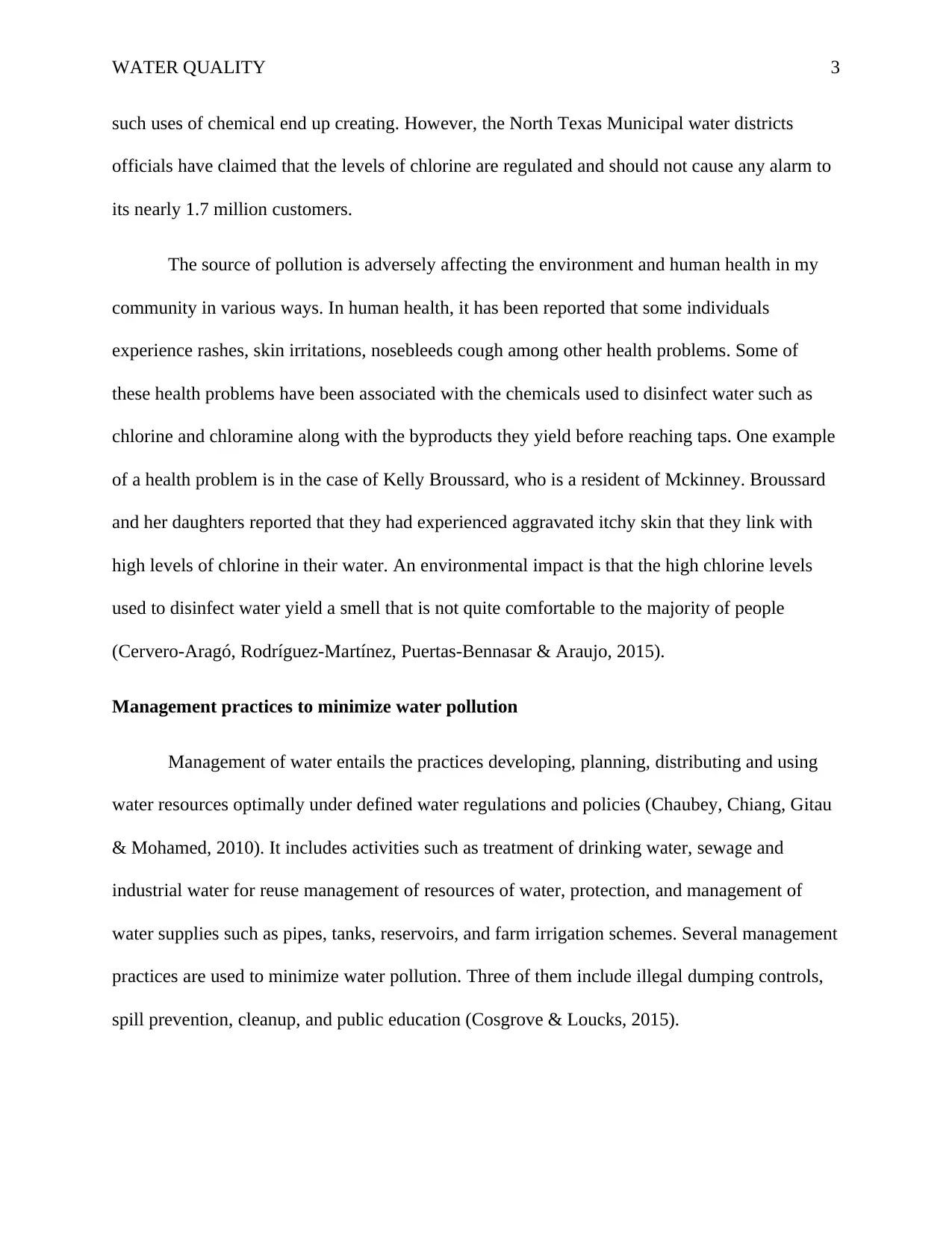
WATER QUALITY 3
such uses of chemical end up creating. However, the North Texas Municipal water districts
officials have claimed that the levels of chlorine are regulated and should not cause any alarm to
its nearly 1.7 million customers.
The source of pollution is adversely affecting the environment and human health in my
community in various ways. In human health, it has been reported that some individuals
experience rashes, skin irritations, nosebleeds cough among other health problems. Some of
these health problems have been associated with the chemicals used to disinfect water such as
chlorine and chloramine along with the byproducts they yield before reaching taps. One example
of a health problem is in the case of Kelly Broussard, who is a resident of Mckinney. Broussard
and her daughters reported that they had experienced aggravated itchy skin that they link with
high levels of chlorine in their water. An environmental impact is that the high chlorine levels
used to disinfect water yield a smell that is not quite comfortable to the majority of people
(Cervero-Aragó, Rodríguez-Martínez, Puertas-Bennasar & Araujo, 2015).
Management practices to minimize water pollution
Management of water entails the practices developing, planning, distributing and using
water resources optimally under defined water regulations and policies (Chaubey, Chiang, Gitau
& Mohamed, 2010). It includes activities such as treatment of drinking water, sewage and
industrial water for reuse management of resources of water, protection, and management of
water supplies such as pipes, tanks, reservoirs, and farm irrigation schemes. Several management
practices are used to minimize water pollution. Three of them include illegal dumping controls,
spill prevention, cleanup, and public education (Cosgrove & Loucks, 2015).
such uses of chemical end up creating. However, the North Texas Municipal water districts
officials have claimed that the levels of chlorine are regulated and should not cause any alarm to
its nearly 1.7 million customers.
The source of pollution is adversely affecting the environment and human health in my
community in various ways. In human health, it has been reported that some individuals
experience rashes, skin irritations, nosebleeds cough among other health problems. Some of
these health problems have been associated with the chemicals used to disinfect water such as
chlorine and chloramine along with the byproducts they yield before reaching taps. One example
of a health problem is in the case of Kelly Broussard, who is a resident of Mckinney. Broussard
and her daughters reported that they had experienced aggravated itchy skin that they link with
high levels of chlorine in their water. An environmental impact is that the high chlorine levels
used to disinfect water yield a smell that is not quite comfortable to the majority of people
(Cervero-Aragó, Rodríguez-Martínez, Puertas-Bennasar & Araujo, 2015).
Management practices to minimize water pollution
Management of water entails the practices developing, planning, distributing and using
water resources optimally under defined water regulations and policies (Chaubey, Chiang, Gitau
& Mohamed, 2010). It includes activities such as treatment of drinking water, sewage and
industrial water for reuse management of resources of water, protection, and management of
water supplies such as pipes, tanks, reservoirs, and farm irrigation schemes. Several management
practices are used to minimize water pollution. Three of them include illegal dumping controls,
spill prevention, cleanup, and public education (Cosgrove & Loucks, 2015).
You're viewing a preview
Unlock full access by subscribing today!
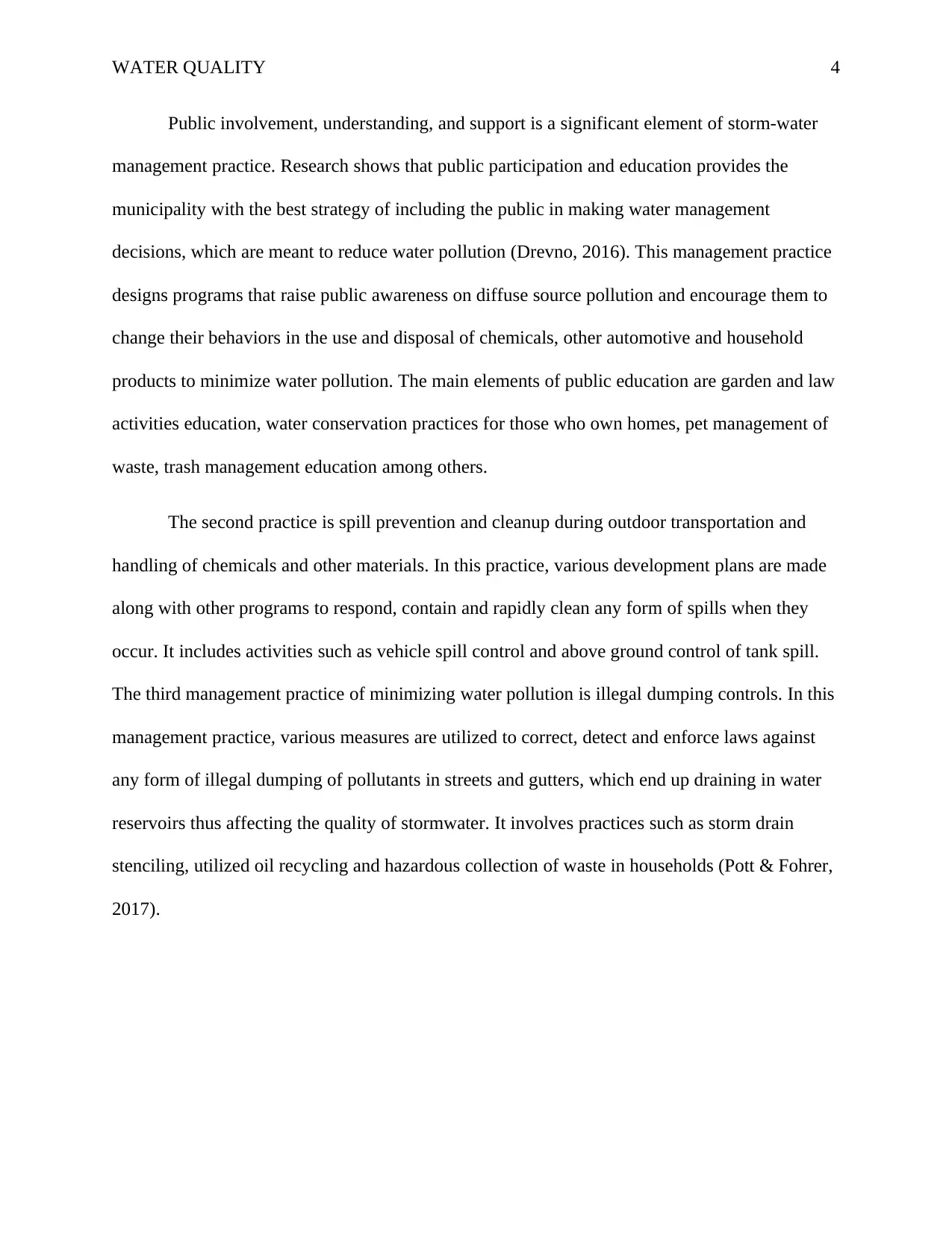
WATER QUALITY 4
Public involvement, understanding, and support is a significant element of storm-water
management practice. Research shows that public participation and education provides the
municipality with the best strategy of including the public in making water management
decisions, which are meant to reduce water pollution (Drevno, 2016). This management practice
designs programs that raise public awareness on diffuse source pollution and encourage them to
change their behaviors in the use and disposal of chemicals, other automotive and household
products to minimize water pollution. The main elements of public education are garden and law
activities education, water conservation practices for those who own homes, pet management of
waste, trash management education among others.
The second practice is spill prevention and cleanup during outdoor transportation and
handling of chemicals and other materials. In this practice, various development plans are made
along with other programs to respond, contain and rapidly clean any form of spills when they
occur. It includes activities such as vehicle spill control and above ground control of tank spill.
The third management practice of minimizing water pollution is illegal dumping controls. In this
management practice, various measures are utilized to correct, detect and enforce laws against
any form of illegal dumping of pollutants in streets and gutters, which end up draining in water
reservoirs thus affecting the quality of stormwater. It involves practices such as storm drain
stenciling, utilized oil recycling and hazardous collection of waste in households (Pott & Fohrer,
2017).
Public involvement, understanding, and support is a significant element of storm-water
management practice. Research shows that public participation and education provides the
municipality with the best strategy of including the public in making water management
decisions, which are meant to reduce water pollution (Drevno, 2016). This management practice
designs programs that raise public awareness on diffuse source pollution and encourage them to
change their behaviors in the use and disposal of chemicals, other automotive and household
products to minimize water pollution. The main elements of public education are garden and law
activities education, water conservation practices for those who own homes, pet management of
waste, trash management education among others.
The second practice is spill prevention and cleanup during outdoor transportation and
handling of chemicals and other materials. In this practice, various development plans are made
along with other programs to respond, contain and rapidly clean any form of spills when they
occur. It includes activities such as vehicle spill control and above ground control of tank spill.
The third management practice of minimizing water pollution is illegal dumping controls. In this
management practice, various measures are utilized to correct, detect and enforce laws against
any form of illegal dumping of pollutants in streets and gutters, which end up draining in water
reservoirs thus affecting the quality of stormwater. It involves practices such as storm drain
stenciling, utilized oil recycling and hazardous collection of waste in households (Pott & Fohrer,
2017).
Paraphrase This Document
Need a fresh take? Get an instant paraphrase of this document with our AI Paraphraser
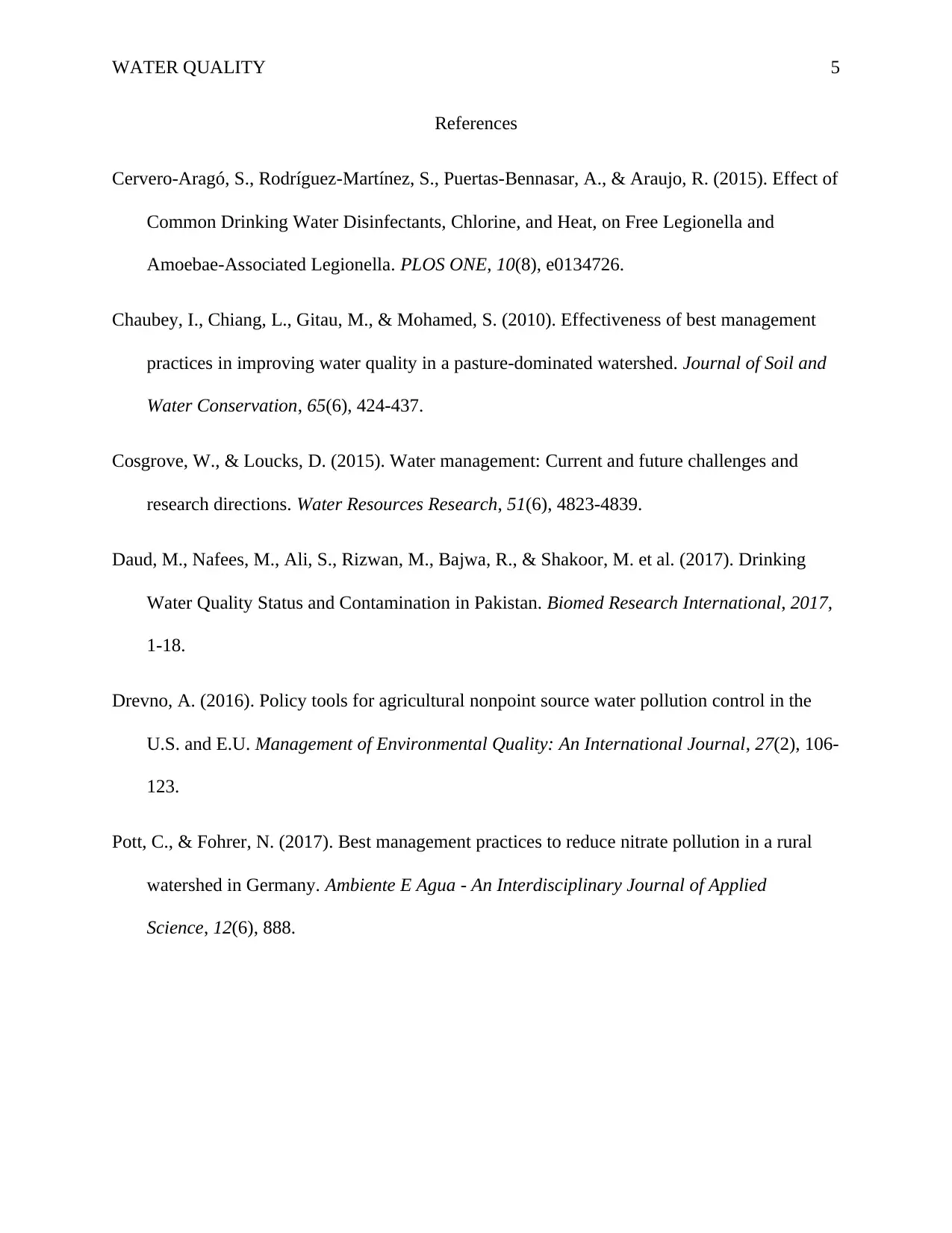
WATER QUALITY 5
References
Cervero-Aragó, S., Rodríguez-Martínez, S., Puertas-Bennasar, A., & Araujo, R. (2015). Effect of
Common Drinking Water Disinfectants, Chlorine, and Heat, on Free Legionella and
Amoebae-Associated Legionella. PLOS ONE, 10(8), e0134726.
Chaubey, I., Chiang, L., Gitau, M., & Mohamed, S. (2010). Effectiveness of best management
practices in improving water quality in a pasture-dominated watershed. Journal of Soil and
Water Conservation, 65(6), 424-437.
Cosgrove, W., & Loucks, D. (2015). Water management: Current and future challenges and
research directions. Water Resources Research, 51(6), 4823-4839.
Daud, M., Nafees, M., Ali, S., Rizwan, M., Bajwa, R., & Shakoor, M. et al. (2017). Drinking
Water Quality Status and Contamination in Pakistan. Biomed Research International, 2017,
1-18.
Drevno, A. (2016). Policy tools for agricultural nonpoint source water pollution control in the
U.S. and E.U. Management of Environmental Quality: An International Journal, 27(2), 106-
123.
Pott, C., & Fohrer, N. (2017). Best management practices to reduce nitrate pollution in a rural
watershed in Germany. Ambiente E Agua - An Interdisciplinary Journal of Applied
Science, 12(6), 888.
References
Cervero-Aragó, S., Rodríguez-Martínez, S., Puertas-Bennasar, A., & Araujo, R. (2015). Effect of
Common Drinking Water Disinfectants, Chlorine, and Heat, on Free Legionella and
Amoebae-Associated Legionella. PLOS ONE, 10(8), e0134726.
Chaubey, I., Chiang, L., Gitau, M., & Mohamed, S. (2010). Effectiveness of best management
practices in improving water quality in a pasture-dominated watershed. Journal of Soil and
Water Conservation, 65(6), 424-437.
Cosgrove, W., & Loucks, D. (2015). Water management: Current and future challenges and
research directions. Water Resources Research, 51(6), 4823-4839.
Daud, M., Nafees, M., Ali, S., Rizwan, M., Bajwa, R., & Shakoor, M. et al. (2017). Drinking
Water Quality Status and Contamination in Pakistan. Biomed Research International, 2017,
1-18.
Drevno, A. (2016). Policy tools for agricultural nonpoint source water pollution control in the
U.S. and E.U. Management of Environmental Quality: An International Journal, 27(2), 106-
123.
Pott, C., & Fohrer, N. (2017). Best management practices to reduce nitrate pollution in a rural
watershed in Germany. Ambiente E Agua - An Interdisciplinary Journal of Applied
Science, 12(6), 888.
1 out of 5
Your All-in-One AI-Powered Toolkit for Academic Success.
+13062052269
info@desklib.com
Available 24*7 on WhatsApp / Email
![[object Object]](/_next/static/media/star-bottom.7253800d.svg)
Unlock your academic potential
© 2024 | Zucol Services PVT LTD | All rights reserved.
